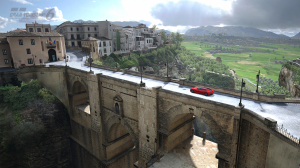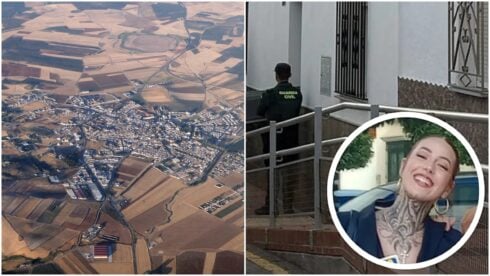By Tom Powell
THE giant stone pillars rise up out of the breathtaking gorge, forming one of the most famous – and photographed – sights in Spain.
But the Puento Nuevo (New Bridge) of Ronda is anything but ‘new’, as it turns out… It has been the centrepiece of this stunning town for more than 200 years.
And there is nothing that prepares you for the moment that you first approach it from above and witness the view and 390 foot drop down to the river below.
Chef Jean Christophe Novelli described it as the ‘cono moment’ (best left untranslated); the second you look down for the first time.
I found myself dazzled by the sheer enormity of the gorge, and I knew that it would be difficult to eventually tear my gaze away from this incredible sight.
But there is nothing about the so-called ‘City of Dreams’ that fails to impress.
Ronda, located in the heart of the soaring Serrania de Ronda mountain range, is precisely the kind of magical town found in fairy tales.
It is no surprise the latest Gran Turismo video game features a circuit that traverses the mountain roads before crossing this very elegant bridge.
Thousands of tourists tread its streets every day (it is the third most visited town in Andalucia) discovering the rich history and culture around every corner.
US President’s wife Michelle Obama made the trip in 2010, touring the old town and discovering the Moorish dynasty with her daughter Sacha.
UK Prime Minister David Cameron has been on several occasions, as have Jamie Oliver and Bill Gates, along with a host of other famous faces.
And when it comes to writers, they have waxed lyrical about its timeless streets, its breathtaking backdrop and hardy locals for centuries.
German poet Rilke donated the name ‘City of Dreams’, Orson Welles took a shine to its bullfighters, while Ernest Hemingway fell in love with, well, just about everything.
“Ronda is the place to go if you are planning to travel to Spain for a honeymoon or for being with a girlfriend,” he wrote. “The whole city and its surroundings are a romantic set. Nice promenades, good wine, excellent food and nothing to do.”
Hemingway, who has a street named after him, would want to revise his last remark if he were alive today.
For the city is actually brimming with things to do and opportunities for adventure.
The most famous attractions are undoubtedly the old town and its three bridges, spanning the gorge and connecting the city’s Roman and Arabic roots with its modern town.
Look out for the 14th century San Miguel bridge, the 17th century Puente Viejo and of course the 18th century Puente Nuevo, which Hemingway used as a setting in his novel For Whom the Bell Tolls, in which he described prisoners being thrown from it to their deaths below during the Spanish Civil War.
A great starting point is at the bottom of the Arabic quarter, today known as the San Miguel district, where you will find the Iberian Peninsula’s best preserved Arabic baths.
The baths, currently undergoing a restoration, were originally built in the 13th century and operated by a water wheel, bringing water up from the River Guadalevin below.

A stroll around the immaculate chambers, arches and columns conjures up images of the lavish lifestyle enjoyed by travellers around the then stronghold of the Kingdom of Granada. A fantastic reconstruction film really brings it to life.
Leaving the baths and walking up the charming cobbled paths takes you into the buzzing old town, which is ripe with key historic buildings and charm personified.
The typical Ronda furniture is abundant, along with pottery and handicrafts, all rich in Moroccan influences.
This quarter, La Ciudad, is the city’s oldest and was a favourite haunt of filmmaker Welles, due to its beautiful Moorish structures interspersed with fine renaissance mansions.
Built in 9 BC, Ronda is one of Spain’s oldest towns and was a key military bastion in the Roman Empire, as well as boasting its own thriving wine industry.
But it was later completely transformed by the Moors, who were responsible for many of the special sights that make it so popular today.
It is possible to walk along the Moorish city walls, past the crumbling Alcazar, and look out into the Serrania, where the view has barely changed in centuries.
Another highlight is the soon to be luxury hotel Casa del Rey Moro, where Michelle Obama surprised onlookers in 2010 by descending the 300 difficult steps down the water mine – ‘La Mina’ – an experience many tourists pass on.
But America’s First Lady wanted to witness at first-hand how the Arabic defenders used to collect water from the river below during violent sieges in the 14th and 15th centuries.
The Obamas also visited the delightful Mondragon palace, which houses the municipal museum as well as beautifully kept water gardens from which the sweeping Serrania can be gazed upon.
Exhibitions vary from Stone Age history to local geology, but the charm of the wonky floor and low ceilings remains throughout.
Nearby is the Santa Maria la Mayor church, which dominates the scenery in the Plaza Duquesa de Parcent, a large shady square perfect for cooling off in.
Originally built in the 14th century as a Muslim Mosque, these days the ornate church is open to tourists and is well worth the visit.
The three naves include striking Gothic columns which survived an earthquake in 1580 that destroyed part of the church.
Nuns can still be spotted crossing the square, reminding you that this part of Ronda’s history is still very much alive.
Across from the church is the landmark neo-classical town hall, with its bold stone arches which are so typical of Ronda.
The Bandoleros Museum is another great option for anyone with so much as a passing interest in swashbuckling bandits, battle and treasure.
And for those with an adventurous side, before crossing the bridge to the new town, there is the opportunity to delve down into the gorge and discover what lies below.
As of this year, a cliff-hugging footpath reminiscent of El Chorro’s Caminito del Rey has been opened, giving a new view of Ronda for those hardy enough to brave it.

Gazing up at the beautiful old buildings teetering perilously on the edge of the cliff is just as spectacular as looking down.
There is just as much to do in the new town as the old, with the bullring – one of Spain’s oldest – taking pride of place.
Once a year the country’s most famous bullfight, the Goyesca, takes place here, with thousands descending on Ronda for the event.
The rest of the time, apart from the odd bullfight in the Spring, the ring is popular for its museum dedicated to the sport. In 1994, it also served as the setting for Madonna’s hit song ‘Take a Bow’.
From outside the bullring and the tourist information office you can catch a traditional horse and carriage for a more authentic tour of the town. It is surprisingly good value.
The large, shady Almeda del Tajo botanical gardens are absolutely vital to experience on a hot summer’s day, providing welcome respite from the city buzz as well as shade and water fountains.
A stone footpath from there, Paseo de los Ingleses, skirts round the edge of the cliff taking full advantage of the sweeping panoramic views on offer.
The heart of the new town is certainly the bustling main shopping street, Carrera Espinel, (known as ‘La Bola’ by locals) which is bursting with handicraft shops, local produce and infinite places to stop off for a cafe con leche.
In fact it is one of the most alive and buzzing in Andalucia, while the square Plaza Socorro is where Blas Infante declared Andalucian independence 200 years ago from its charming Casino.
The journey to Ronda, which once took four hours to undertake on barely passable roads, is now less than an hour from the coast.
But that first sighting as you wind down through the mountain is still just as spellbinding, as the ‘City of Dreams’ comes to life.
Click here to read more News from The Olive Press.







I don’t think there is a translation for ‘cono moment’!
” the third most visited town in Spain ” ?? Don’t be absurd.
Yes that should be Andalucia …